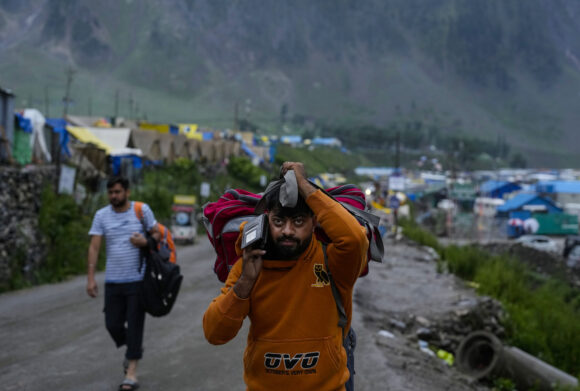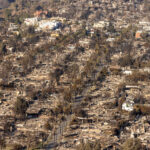SRINAGAR, India (AP) — Emergency workers rescued thousands of pilgrims after flash floods triggered by sudden rains swept through their makeshift camps during an annual Hindu pilgrimage to an icy Himalayan cave in Indian-controlled Kashmir, officials said Saturday. At least 16 people have died and dozens were injured.
Authorities suspended the pilgrimage for two days as rains continued to lash the region. Teams of rescuers from India’s military, paramilitary and police as well as disaster management officials combed through the slippery mountain tracks and used thermal imaging devices, sniffer dogs and through-the-wall radars to locate dozens of missing.
They dug through mud, sand and rocks that swamped the campsites on Friday evening after hurtling down with a gush of water near the cave shrine revered by Hindus. Civilian and military helicopters evacuated the injured to hospitals.
Thousands of people were in the mountains when the rains struck.
Officials said about 15,000 devotees were moved to safer locations and at least five dozen injured were administered first aid at base camp hospitals set up for the pilgrimage, which is undertaken by hundreds of thousands of Hindus from across India.
Groups of pilgrims are staggered over 1 1/2 month for security and logistical reasons.
Ravi Dutt, the 69-year-old Hindu ascetic from eastern West Bengal state, was camping near the cave on Friday evening. He said that suddenly water gushed down from a mountain “sweeping away men, women and our belongings too.”
“Everything was buried under a mountain (of mud and rocks),” Dutt said as he broke down. “I have never seen such an incident in my life.”
Abdul Ghani, a Kashmiri porter who rents his pony to pilgrims, said it was an utter chaos. “I just bundled a devotee on my pony and never looked back,” he said.
Indian Prime Minister Narendra Modi expressed anguish over the deaths. Manoj Sinha, New Delhi’s top administrator in the region, said: “Our priority is to save the lives of people. Instructions have been issued to provide all necessary assistance to pilgrims.”
The Amarnath pilgrimage began on June 30 and tens of thousands of devotees have already visited the cave shrine where Hindus worship Lingam, a naturally formed ice stalagmite, as an incarnation of Shiva, the god of destruction and regeneration.
This year, officials expect nearly 1 million visitors after a two-year gap due to the coronavirus pandemic.
Worshippers trek to the cave along two routes through lush green meadows and rocky and forested mountain passes with a view of glacial lakes and snowy peaks. A traditional route via the southern hill resort of Pahalgam takes three days while a trip through northeastern Baltal lasts one day. Some pilgrims use helicopter services to make quick visits.
The cave, at 13,500 feet (4,115 meters) above sea level, is covered with snow most of the year except for the short summer period when it is open to pilgrims.
Hundreds of pilgrims have died in the past due to exhaustion and exposure to harsh weather during the journey through the icy mountains. In 1996, thousands were caught in a freak snowstorm, leading to more than 250 fatalities.
The pilgrimage concludes on Aug. 11, a full-moon night that Hindus say commemorates Shiva revealing the secret of the creation of the universe.
Apart from weather-related hazards, officials have said that pilgrims face an increased threat of attacks from Muslim rebels who have fought for decades against Indian rule. This year, for the first time, devotees are tagged with a wireless tracking system. Tens of thousands of police and soldiers also guard the routes.
The pilgrimage has been targeted in the past by suspected rebels, who accuse Hindu-majority India of using it as a political statement to bolster its claim on the Muslim-majority disputed region.
At least 50 pilgrims have been killed in three dozen attacks blamed on militants since an armed rebellion began in Indian-controlled Kashmir in 1989 for the region’s independence or a merger with Pakistan, which controls a part of the territory.
About the photo: Hindu pilgrims return back after a cloudburst at Baltal, 105 kilometers (65miles) northeast of Srinagar, Indian controlled Kashmir, Saturday, July 9, 2022. More than ten pilgrims have been killed and many feared missing after a cloudburst triggered a flash flooding during an annual Hindu pilgrimage to an icy Himalayan cave in Indian-controlled Kashmir. Officials say the cloudburst near the hollowed mountain cave revered by Hindus on Friday sent a wall of water down a mountain gorge and swept about two dozen encampments and two makeshift kitchens. (AP Photo/Mukhtar Khan)
Was this article valuable?
Here are more articles you may enjoy.


 Bankrupt 23andMe’s DNA Data Gets Sale Nod as Concerns Linger
Bankrupt 23andMe’s DNA Data Gets Sale Nod as Concerns Linger  UK to Compel 1,000 Firms to Shore up Cyber Defenses After Hacks
UK to Compel 1,000 Firms to Shore up Cyber Defenses After Hacks  Catastrophe Experts Tap AI to Tackle Soaring Insured Losses
Catastrophe Experts Tap AI to Tackle Soaring Insured Losses  California’s Snowpack Data Likely Signals Another Fire-Prone Summer
California’s Snowpack Data Likely Signals Another Fire-Prone Summer 